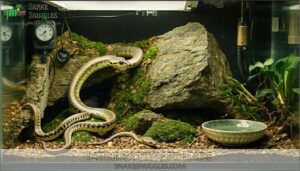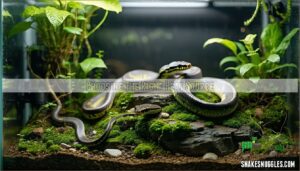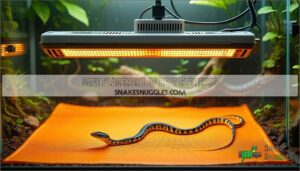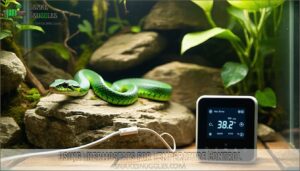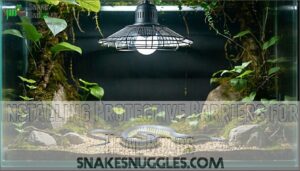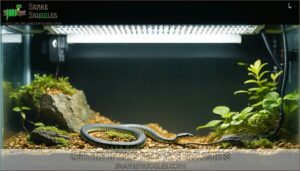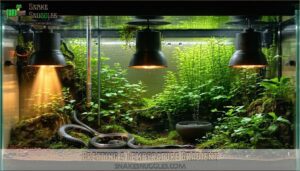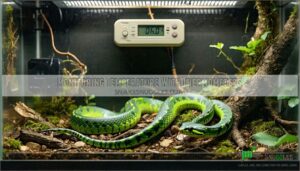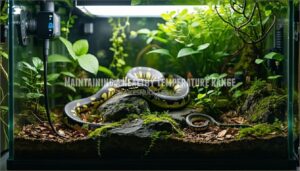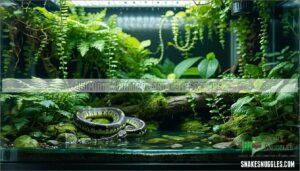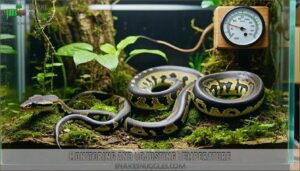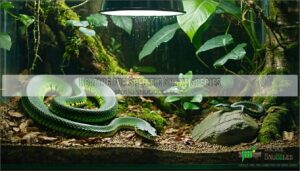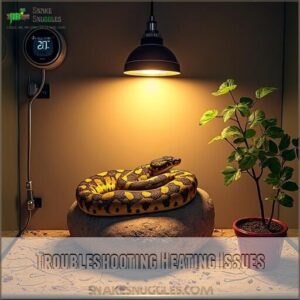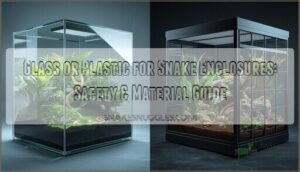This site is supported by our readers. We may earn a commission, at no cost to you, if you purchase through links.
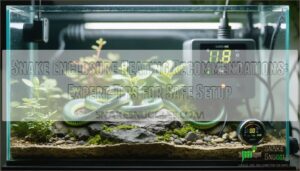
Start with a reliable heat source like a heat mat or ceramic heat emitter. Set it up on one side of the enclosure to create a temperature gradient—your snake needs a cozy warm spot and a cooler zone to regulate its body heat.
Use thermostats to prevent overheating; nobody likes a cooked snake! Aim for species-specific temperatures—most snakes need around 75–90°F in their basking area.
Thermometers are your best friend for monitoring. Curious about the right gear and setup tricks? Stick around to perfect your setup.
Table Of Contents
- Key Takeaways
- Heating Essentials for Snakes
- Choosing The Right Heat Source
- Setting Up a Heat Source
- Lighting Options for Snake Enclosures
- Temperature Gradients and Zoning
- Maintaining a Healthy Temperature Range
- Humidity Control and Temperature
- Monitoring and Adjusting Temperature
- Heating for Specific Snake Species
- Troubleshooting Heating Issues
- Frequently Asked Questions (FAQs)
- How do I heat my snake enclosure?
- How do you protect a snake enclosure from overheating?
- How do you heat a snake?
- How do you keep a snake warm?
- How do you care for a snake enclosure?
- Can a snake enclosure heat a snag?
- What is the best heat source for a snake enclosure?
- What temperature should my snake enclosure be?
- What is the best way to heat a snake tank?
- Do snakes need a heat mat 24/7?
- Conclusion
Key Takeaways
- Use heat mats, ceramic heat emitters, or radiant panels with thermostats to create a warm side (80-85°F) and a cool side (75-80°F) in the enclosure.
- Place thermometers strategically in warm and cool zones to monitor temperatures accurately and prevent overheating or underheating.
- Create a temperature gradient by setting up warm basking spots and cooler areas, helping your snake thermoregulate effectively.
- Adjust heat setups for your snake’s species, life stage, and natural habitat needs, and ensure you also balance humidity for optimal health.
Heating Essentials for Snakes
You’ve got to get the heating just right because snakes can’t regulate their body temperature like we do.
A proper setup with warm and cool zones mimics their natural habitat and keeps them healthy.
Importance of External Heat Sources
Snakes are ectotherms, meaning they rely on external temperatures to keep their bodies functioning properly.
Ectothermic by nature, snakes thrive when external temperatures meet their needs—turning a warm, cozy setup into a life-saving necessity.
A well-designed heating setup is key for digestion support, immune function, and maintaining activity levels. Think of heat sources like heat pads, ceramic emitters, or radiant panels as life-saving tools in any snake enclosure heating recommendation.
These snake enclosure heat sources let your pet regulate its body temperature, mimic natural habitats, and stay healthy. Without proper reptile heating, cold spots can cause stress or illness.
Always use reliable equipment and check for overheating to keep your snake’s environment safe and comfortable—because a cozy snake is a happy snake!
Understanding Thermal Gradients
Think of a thermal gradient as your snake’s way to self-regulate its temperature, just like adjusting the thermostat at home.
A proper temperature gradient mimics natural habitats, giving snakes zones to warm up or cool off.
Keep one side of the snake enclosure between 75-80°F and the other at 80-85°F.
Adding a heat mat on one end creates these temperature zones, promoting healthier digestion and immunity.
Stick to consistent monitoring to guarantee the snake enclosure heating recommendations stay on point, keeping your snake comfy and happy.
Temperature Requirements for Snakes
Your snake’s health depends on maintaining proper optimal temperatures in the enclosure.
Aim for a temperature gradient with these steps:
- Keep the warm side between 80°F-85°F and the cool side around 75°F-80°F.
- Allow for night drops of 3-5°F to mimic natural cycles.
- Adjust for species variation and seasonal changes.
- Use reliable tools like thermostats and thermometers for precise control.
The key to successful temperature management is following these guidelines to ensure your snake’s environment remains healthy and thriving.
Choosing The Right Heat Source
When choosing a heat source for your snake’s enclosure, it’s vital to balance efficiency and safety.
From heat mats to ceramic emitters, each option has unique benefits, so knowing your snake’s needs is key to keeping them happy and healthy.
Heat Pads and Mats
Creating the perfect heating setup with heat pads or mats (also known as under tank heaters or UTH) is a breeze when you know the essentials.
These devices provide consistent warmth, but attention to detail guarantees your snake’s safety and comfort. A vital aspect is maintaining optimal temperature ranges for your ball python’s health.
- UTH placement: Install under one-third of the enclosure.
- Wattage selection: Match to your enclosure’s size.
- Thermostat integration: Prevent overheating by regulating temperatures.
- Substrate compatibility: Use non-flammable materials to prevent damage.
- Safety concerns: Avoid direct snake contact with the mat.
Stay vigilant, and your snake will thank you with playful slithers!
Radiant Heat Panels and Cables
Radiant heat panels and cables offer a sleek way to manage snake enclosure heating.
They provide a unique solution for reptile owners.
Panels excel at energy efficiency and creating steady temperature gradients, while heat cables suit curved setups.
Guarantee cable safety with careful placement.
Many reptile owners purchase these heat solutions online.
Here’s a quick comparison:
| Feature | Heat Panel | Heat Cable |
|---|---|---|
| Installation | Simple | Moderate |
| Energy Efficiency | High | Variable |
| Ideal Use | Large enclosures | Custom shapes |
Ceramic Heat Emitters and Bulbs
Ceramic heat emitters (CHEs) are excellent for nocturnal heating, providing infrared radiation without light.
Unlike basking bulbs or heat lamps, a ceramic heater focuses solely on warmth, mimicking natural environments.
Choose the right wattage selection based on your snake’s enclosure size—too high might overheat, while too low won’t cut it.
For CHE safety, always use a thermostat to regulate temperatures and prevent burns.
With proper care, the CHE lifespan can last years.
Pair it with a thermometer to guarantee consistent heat and a cozy, safe space for your scaly buddy.
Setting Up a Heat Source
When setting up a heat source, you’ll need to position it carefully to create a safe and consistent temperature gradient.
Don’t skip using a thermostat—it’s the key to keeping your snake cozy without overheating its home.
Safe Placement of Heat Elements
When placing heat elements, safety should come first to prevent burns or fire hazards.
Heat mats should cover about one-third of the tank’s floor for proper heat mat placement. Secure mounting is essential for heat lamp placement; a loose lamp could spell trouble.
Use a safety mesh or DIY barrier ideas to keep your snake safe from direct contact and electrical hazards. Make certain proper element distance—too close can overheat, while too far won’t provide enough warmth.
Choose safe materials like ceramic for stability. Don’t forget about ventilation to avoid trapped heat.
It’s also important to evaluate radiant heat panels as a safe and efficient heating option. Smart placement keeps your snake cozy and your setup worry-free!
Using Thermostats for Temperature Control
Thermostats are your snake enclosure’s safety net.
A proportional thermostat guarantees gradual temperature changes, minimizing risks like overheating.
Proper thermostat placement is vital—position the probe near the warm zone for accurate monitoring.
Thermostat calibration keeps temperature control precise, creating a stable environment for your snake.
Many models include safety features like automatic shutoff if temperatures spike.
Consider a proportional reptile thermostat for ideal control.
Consider a backup thermostat for added security.
With reliable thermostat control, you’ll provide a comfortable, worry-free habitat for your snake to thrive.
It’s peace of mind made simple!
Installing Protective Barriers for Heat Bulbs
Protective barriers for heat bulbs are a must for snake safety. Use strong, heat-proof materials like wire mesh to prevent direct contact.
Keep bulbs at a safe distance to avoid burns or electrical fires. Consider these tips:
- Choose durable barrier materials.
- Confirm proper bulb distance.
- Use fine mesh size for DIY barriers.
- Prioritize heat lamp safety.
- Secure bulb guards effectively.
To ensure the well-being of snakes, it is crucial to follow these guidelines carefully and maintain a safe environment by using protective barriers.
Lighting Options for Snake Enclosures
You’ve got a few great options regarding lighting your snake’s enclosure, and each plays an important role in its health.
From UVB bulbs helping with vitamin D synthesis to LED lights creating ambient brightness, lighting isn’t just about visibility—it’s a key part of keeping your snake happy and thriving.
Ambient Lighting With LED and Fluorescent Tubes
Ambient lighting isn’t just about looks—LED lights and fluorescent tubes offer more than you’d expect for snake enclosure lighting.
They enhance your snake’s comfort by mimicking natural light cycles without adding extra heat. Plus, they keep your wallet happy with energy efficiency.
Here are some standout perks:
- LED lifespan: LEDs outlast traditional bulbs, saving you time and money.
- Color spectrum: Offers stunning visual appeal for you and your snake.
- Light diffusion: Guarantees even lighting that works well with live plants.
Perfect lighting, happy snake!
UVB Lighting for Vitamin D Synthesis
UVB lighting plays a big role in your snake’s health by supporting vitamin D3 synthesis, which is essential for strong bones and immunity.
When setting up snake enclosure UVB lighting, pick a reputable UVB bulb matched to your enclosure size. Position it above the basking spot for maximum exposure—not directly on your snake!
Follow the manufacturer’s lighting spectrum and duration guidelines to mimic natural daylight.
Without UVB benefits, diurnal snakes may face health risks from improper vitamin D synthesis.
Regularly check your bulbs to avoid supplementation risks and guarantee consistent, healthy lighting options for your snake.
Basking Bulbs and Heat Lamps
Think of basking bulbs and heat lamps as your snake’s private sunbeam. These create a cozy basking spot with just the right warmth.
- Bulb wattage: Fit to your enclosure size.
- Basking distance: Prevent burns with proper setup.
- Heat spectrum: Choose daytime basking bulbs.
- Lamp lifespan: Replace every 6-12 months.
- Reflector types: Direct heat where it’s needed most.
Temperature Gradients and Zoning
Your snake’s comfort depends on creating a proper temperature gradient, with warm and cool zones for effective thermoregulation.
Think of it like a reptile spa—too hot or too cold, and they won’t feel their best.
Creating a Temperature Gradient
A proper temperature gradient keeps your snake cozy and healthy.
Use a quality heat source to create warm and cool zones for self-regulation. Place basking spots strategically to aid digestion support. Night temperatures should gently drop for natural cycles.
Always monitor with thermometers.
| Item | Use |
|---|---|
| Heat Mat | Provides consistent warmth |
| Basking Spot | Key for thermoregulation |
| Thermometer | Guarantees precise control |
Zoning for Different Temperature Requirements
A snake enclosure’s temperature zones should mimic its natural habitat and unique needs.
By creating microclimate zones, you let your snake self-regulate its temperature comfortably. Use vertical gradients for arboreal species and adjust substrates for better heat distribution.
Design seasonal zones for variety and balance. Every species zoning setup guarantees care customized for your snake.
- Include warm and cool zones.
- Position basking spots (88-92°F).
- Use vertical gradients for climbing species.
- Monitor substrate impact on heat retention.
- Adjust zones seasonally.
Monitoring Temperature With Thermometers
Monitoring temperature in your snake’s enclosure is essential for their health.
Reliable thermometers guarantee accurate readings. Follow these tips:
- Digital vs. Analog: Digital thermometers offer better accuracy for temperature monitoring.
- Thermometer Placement: Place thermometers in warm and cool zones for balanced readings.
- Calibration Frequency: Calibrate equipment routinely to maintain precise readings and troubleshoot potential issues.
Consider using digital reptile thermometers for precision. Your reptile thermometer guarantees the best comfort!
Maintaining a Healthy Temperature Range
Your snake’s health depends on keeping the enclosure’s temperature just right, like Goldilocks finding her perfect porridge.
Too hot or too cold can cause serious problems, so it’s important to set a safe range and check it regularly, ensuring your snake’s environment remains healthy and safe.
Avoiding Overheating and Underheating
A well-tuned thermostat keeps your snake cozy without turning its home into a sauna.
Overheating prevention starts with regular thermostat calibration and gradient monitoring. Keep a digital thermometer handy—spot-checking temps guarantees things stay just right.
Equipment maintenance is key; broken heaters don’t just underperform, they risk your pet’s health. Use insulation methods like foam boards to regulate heat efficiently.
Have emergency measures like backup heat packs for outages. A balanced snake enclosure heating setup keeps your scaly buddy active and stress-free.
Temperature control isn’t optional—it’s lifesaving! A well-tuned thermostat and regular thermostat calibration are crucial for maintaining the right environment. Equipment maintenance and emergency measures are also vital for ensuring your snake’s health and well-being.
Adjusting Temperature for Day and Night Cycles
Setting up day/night cycles for your snake is like creating a mini weather system in their enclosure.
Use a thermostat and timers to adjust temperatures gradually, mimicking natural habitat shifts.
Aim for a night temperature drop of 3-5°F.
Automated light cycles and thermostat programming save effort while ensuring stability.
These temperature adjustments help snakes stay active during the day and unwind at night.
Humidity and Temperature Interactions
Humidity and heat work hand-in-hand in your snake’s enclosure.
Incorrect humidity levels can cause shedding issues or even harm respiratory health.
Use misting systems or a heat mat under damp substrate to stabilize ideal levels.
Ideal humidity levels vary by snake species.
Regular temperature monitoring guarantees your setup’s working as intended, ensuring a balanced temperature gradient and good humidity control, which mean happier, healthier snakes—and fewer surprises for you, resulting in a better snake care experience.
Humidity Control and Temperature
You need to balance humidity and temperature to keep your snake healthy and comfortable.
Too much or too little moisture can mess with shedding, breathing, and overall health, so it’s worth getting it right.
Understanding The Relationship Between Humidity and Temperature
Humidity and temperature are like dance partners in your snake enclosure—one depends on the other for balance.
Humidity and temperature move together in perfect harmony, creating the ultimate comfort and health for your snake’s cozy habitat.
Proper humidity prevents shedding issues and supports respiratory health, while stable temperatures maintain a thermoregulation balance for your snake’s comfort.
Here’s what to aim for:
- Keep humidity levels steady: A moist environment helps your snake shed its skin smoothly.
- Maintain the temperature gradient: A balanced spectrum of warm and cool areas promotes natural behavior.
- Monitor interactions: Temperature impacts humidity, so watch both closely to guarantee a healthy habitat.
Finding this sweet spot keeps your snake thriving!
Using Humidifiers and Misting Systems
If your snake’s habitat feels drier than a desert, misting systems or humidifiers can work wonders.
They guarantee accurate humidity control, creating humidity gradients that mimic nature.
Adjust misting frequency based on species needs, like tropical snakes requiring higher levels.
Regular system maintenance and using clean water improve reliability.
Hygrometers aid in monitoring humidity levels, which helps prevent respiratory issues.
Monitor humidity levels with hygrometers to prevent issues.
Think of it as giving your snake a mini rainforest retreat!
Maintaining Ideal Humidity Levels
Keeping the right humidity levels in your snake enclosure isn’t magic—it just takes some know-how.
Proper humidity control helps prevent shedding issues and supports respiratory health.
Here’s what to do:
- Use a humidity-friendly substrate like coco coir to lock in moisture.
- Install misting systems for consistent humidity management—your snake will thank you!
- Place a digital hygrometer to monitor humidity levels precisely.
Healthy snake enclosure humidity is all about balance.
With these steps, you’re closer to providing a perfect microclimate for your snake buddy.
Monitoring and Adjusting Temperature
To keep your snake healthy, you’ll need to regularly check and adjust temperatures in its enclosure.
Using reliable thermometers and hygrometers makes this easy and helps you spot issues before your pet gets too chilly or overheated.
Using Thermometers and Hygrometers
Accuracy matters when monitoring temperature and humidity in your snake’s home.
Use thermometers and hygrometers—digital ones are precise and easy to read.
Place them strategically at the warm and cool sides for reliable readings.
Calibrate regularly to avoid false data, and consider models with data logging to track trends effortlessly.
Analog devices work too but may need more troubleshooting to ensure reliable readings.
Adjusting Temperature for Different Life Stages
You’ve mastered your thermometer readings—now fine-tune them for each snake stage.
Hatchling temperatures should stay warm and steady, meeting baby snake needs. Juveniles need slightly boosted warmth to fuel growth, while adults thrive with stable, moderate heating.
Ready to breed? Use cooler breeding temps to mimic brumation prep.
Proper adjustment supports shedding, growth, and health throughout every life stage of your snake’s journey, ensuring a stable and moderate environment.
Heating for Specific Snake Species
Not all snakes need the same heat, so it’s key to match their setup to their wild environment.
From tropical boas to desert-dwelling pythons, you’ll want to research your snake’s natural habitat to keep it healthy and comfortable.
Temperature Requirements for Popular Pet Snakes
Your snake enclosure heating recommendations depend on the species.
Ball Python temps should stay 80-85°F, with a basking spot at 88-92°F.
Corn snake heat ranges from 70-85°F, with warm basking zones.
King snake needs hover around 75-85°F.
Don’t forget Rosy Boas—they prefer 78-85°F.
Accurate thermometers prevent missteps.
Provide both warm and cool zones so your pet handles their own comfort.
This allows the snake to regulate its body temperature effectively, ensuring a healthy environment, with accurate temperature control being crucial.
Heating for Different Habitat Types
How do you keep your snake cozy in its unique habitat?
In desert enclosures, ceramic heat emitters work wonders for arid vibes.
For arboreal heating, radiant heat panels create comfortable, upward warmth.
Meanwhile, aquatic setups thrive with controlled heat mats to regulate water and land zones.
Always include a temperature gradient in your snake enclosure setup — safe, scientific, and essential for proper reptile heating!
Researching Species-Specific Temperature Needs
Every snake species has its own quirks regarding temperature requirements.
To nail it, research your snake’s geographic origin and life stage—this helps mimic natural habitat thermoregulation in their enclosure.
For example, ball pythons thrive at 75-92°F.
Consider how dietary needs, like digestion, may affect heating.
Reliable tools like thermostats and heat pads guarantee precision.
Understanding species-specific needs, whether tropical or desert, keeps your snake cozy and healthy.
A well-researched setup is their ticket to royalty with proper temperature requirements.
Troubleshooting Heating Issues
If your snake’s enclosure isn’t staying at the right temperature, don’t panic—most issues are easy to fix once you spot the problem.
From faulty thermostats to uneven heat, understanding common heating problems can help you quickly restore the ideal environment, which is crucial for your snake’s health, and quickly addressing these issues is key to maintaining a stable environment.
Common Heating Problems and Solutions
Heating problems can be frustrating, but most are easy to fix.
Inaccurate thermostats cause temperature fluctuations, so check yours often. Bulb burnout? Replace it quickly to avoid gradient imbalance.
Cold spots in larger enclosures may need extra heat sources. Underheating happens with weak setups, while overheating risks increase during power outages.
Regularly inspect your equipment to keep your snake comfortable and safe.
Identifying Signs of Inadequate Heating
Your snake’s lethargy and poor appetite might mean something’s off.
Watch for these signs:
- Lethargy Signs: Your snake seems slow or uninterested.
- Shedding Issues: Patches of stuck skin linger.
- Digestive Problems: Food isn’t staying down.
- Immune Suppression: Illnesses occur more often.
- Activity Levels: Less movement in the enclosure.
Use temperature monitoring to guarantee proper heat regulation for snake health.
Adjusting Heating Systems for Optimal Performance
Feeling a little chill in your setup? Let’s fine-tune your snake’s environment!
- Gradient Fine-tuning: Position heat mats for clear temperature zones.
- Thermostat Calibration: Regularly adjust for precise temperature control.
- Insulation Techniques: Line enclosures to maintain warmth effectively.
- Seasonal Adjustments: Combat winter dips with extra heating like ceramic emitters.
Proper temperature monitoring guarantees a happy, active snake!
Frequently Asked Questions (FAQs)
How do I heat my snake enclosure?
To heat your snake’s enclosure, use heat mats, ceramic heat emitters, or radiant panels with thermostats to maintain a gradient.
Provide a warm spot (80-85°F) and a cooler zone (75-80°F).
Monitor with thermometers!
How do you protect a snake enclosure from overheating?
Place thermostats on all heat sources to prevent overheating, and use thermometers to monitor temperatures daily.
Add ventilation, like mesh panels or air holes, for airflow.
Never underestimate how fast things can get toasty!
How do you heat a snake?
Did you know snakes can’t regulate their own body heat?
Use a heat lamp or mat controlled by a thermostat to create a warm side (80-85°F) and a cool side (75-80°F) for them.
How do you keep a snake warm?
You can keep a snake warm by creating a thermal gradient using heat mats, lamps, or ceramic heaters, paired with thermostats to control temperature.
Remember, snakes love options, just like picking comfy spots!
How do you care for a snake enclosure?
Design a snake enclosure with a proper thermal gradient, secure hiding spots, and consistent humidity.
Use thermometers, thermostats, and safe heat sources for temperature regulation.
Regularly clean and inspect everything to keep your snake thriving.
Can a snake enclosure heat a snag?
Your snake enclosure won’t snag heat like a cozy blanket, but it can retain warmth effectively.
Use thermostats and insulation to maintain consistent temperatures, ensuring your snake stays comfy without overheating or chilling.
What is the best heat source for a snake enclosure?
To heat a snake enclosure, the best options are heat mats or ceramic heat emitters.
They’re reliable, safe, and efficient.
Use a thermostat to control temperature, ensuring your snake stays cozy without overheating.
What temperature should my snake enclosure be?
Think of your snake’s enclosure like a cozy thermostat.
Keep the warm side at 80-85°F, the cool side at 75-80°F, and a basking spot around 88-92°F for ideal health and happiness.
What is the best way to heat a snake tank?
Use a thermostat-controlled heat mat under one-third of the enclosure to create a warm zone.
Pair it with a ceramic heat emitter or radiant heat panel above for even heating and nighttime temperature drops.
Do snakes need a heat mat 24/7?
You don’t need a heat mat 24/7, as snakes require a temperature gradient, allowing them to regulate their body heat by moving between warm and cool areas.
Conclusion
Ever seen a lizard basking on a rock? That’s your snake’s goal—simple comfort with a science-backed setup.
A proper snake enclosure heating system isn’t just a luxury; it’s essential for health and happiness. By choosing the right heat sources, creating thermal gradients, and monitoring with thermometers, you’ll nail their species-specific needs.
Don’t forget thermostats—they’re lifesavers! With these expert snake enclosure heating recommendations, your slithery friend will thrive in a perfect, cozy environment.
Now, warm up that habitat!

